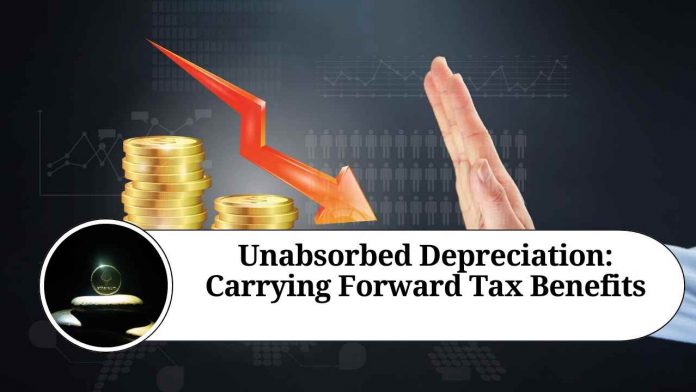Introduction
In the world of business, depreciation is a common concept that allows companies to allocate the cost of their assets over their useful lives. This process helps in accurately reflecting the wear and tear, obsolescence, and diminishing value of assets over time. However, there are instances where the depreciation claimed by a company exceeds its taxable income, resulting in unabsorbed depreciation. In such cases, the tax benefits associated with this unabsorbed depreciation can be carried forward, offering a potential advantage for businesses in subsequent years. In this blog post, we will delve into the concept of unabsorbed depreciation, explore its significance, and understand how it can be leveraged effectively.
Understanding Unabsorbed Depreciation
Unabsorbed depreciation refers to the depreciation expense that remains unutilized or unclaimed due to insufficient profits or taxable income in a given financial year. It typically occurs when a company’s depreciation claim exceeds its taxable income, resulting in a situation where the full benefit of depreciation cannot be availed immediately. Instead of losing out on this tax benefit, the government allows businesses to carry forward the unabsorbed depreciation to subsequent years.
Carrying Forward Tax Benefits
Carrying forward unabsorbed depreciation can be a valuable strategy for businesses, as it enables them to offset future taxable income, thereby reducing their tax liability. This provision ensures that companies do not miss out on the depreciation benefits they are entitled to, even if they couldn’t fully utilize them in a particular year. Here’s how the process generally works:
Record and maintain accurate records:
It is crucial for businesses to maintain accurate records of their unabsorbed depreciation. This involves keeping track of the unabsorbed amount, the year in which it originated, and any adjustments made in subsequent years.
Claiming the carry forward:
When a company has taxable income in a subsequent financial year, it can offset a portion of that income with the unabsorbed depreciation from prior years. The specific rules and limitations for carrying forward unabsorbed depreciation may vary across jurisdictions, so it is important to consult the relevant tax laws and regulations.
Set-off against future profits:
The unabsorbed depreciation can be set off against the profits of subsequent years, reducing the taxable income and thereby lowering the tax liability. By leveraging this provision, businesses can potentially save on taxes and improve their financial position.
Benefits and Considerations
Tax savings:
Carrying forward unabsorbed depreciation can lead to substantial tax savings for businesses. It allows them to optimize their tax planning by reducing future tax liabilities and improving cash flow.
Smooth financial operations:
Unabsorbed depreciation can be particularly advantageous for businesses facing temporary setbacks or fluctuating profitability. It provides a cushion by allowing them to offset future profits against the losses incurred in previous years, ensuring smoother financial operations.
Compliance and regulations:
It is crucial to comply with the relevant tax laws and regulations while carrying forward unabsorbed depreciation. Familiarize yourself with the specific provisions applicable in your jurisdiction to ensure proper utilization of this tax benefit.
Conclusion
Unabsorbed depreciation is a valuable tax benefit that businesses can leverage to their advantage. By carrying forward the unclaimed depreciation from one financial year to another, companies can offset future taxable income, reduce tax liabilities, and improve their financial standing. However, it is essential to stay abreast of the specific rules and limitations governing the carry forward of unabsorbed depreciation in your jurisdiction. By employing effective tax planning strategies, businesses can harness the power of unabsorbed depreciation and navigate their way towards increased profitability and financial success.
Read more useful content:
Frequently Asked Questions (FAQs)
Q: What is unabsorbed depreciation?
A: Unabsorbed depreciation refers to the depreciation expense that remains unclaimed or unutilized by a company due to insufficient taxable income to offset the full depreciation amount in a given financial year.
Q: Why does unabsorbed depreciation occur?
A: Unabsorbed depreciation occurs when the depreciation claimed by a company exceeds its taxable income. This typically happens when a company has incurred significant depreciation expenses but has low or negative profits, resulting in the inability to fully utilize the depreciation benefits.
Q: How can unabsorbed depreciation be beneficial for businesses?
A: Unabsorbed depreciation can be beneficial for businesses because it allows them to carry forward the unclaimed depreciation to future years. This provides an opportunity to offset future taxable income, reducing tax liabilities and potentially leading to significant tax savings.
Q: Can unabsorbed depreciation be carried forward indefinitely?
A: The carry forward period for unabsorbed depreciation varies across jurisdictions. While some countries allow indefinite carry forward, others impose limitations on the number of years or set a specific time limit within which the unabsorbed depreciation must be utilized.
Q: How is unabsorbed depreciation carried forward?
A: Carrying forward unabsorbed depreciation involves recording and maintaining accurate records of the unclaimed depreciation. When a company has taxable income in subsequent years, it can set off a portion of that income with the unabsorbed depreciation from previous years, reducing the taxable income and lowering the tax liability.
Q: Can unabsorbed depreciation be set off against any income?
A: Generally, unabsorbed depreciation can be set off against any income generated by the business in subsequent years. However, there may be restrictions or specific rules governing the set-off process, depending on the tax laws and regulations of the jurisdiction.
Q: What happens if a company undergoes a change in ownership or structure?
A: In the case of a change in ownership or structure, the rules for carrying forward unabsorbed depreciation may vary. Some jurisdictions allow the continuity of the unabsorbed depreciation benefits, while others may have specific provisions or limitations regarding such situations. It is important to consult the applicable tax laws or seek professional advice in such cases.
Q: Are there any compliance requirements for carrying forward unabsorbed depreciation?
A: Yes, businesses must comply with the relevant tax laws and regulations when carrying forward unabsorbed depreciation. This includes accurately recording and maintaining records of the unabsorbed amount, adhering to the specified carry forward period, and fulfilling any reporting or documentation requirements mandated by the tax authorities.
Q: Can unabsorbed depreciation be carried forward in case of a loss-making business?
A: Yes, unabsorbed depreciation can be carried forward even if a business has incurred losses. The unabsorbed depreciation can be utilized to offset future profits once the business generates taxable income, potentially reducing the tax liability in those years.
Q: Are there any limitations or restrictions on carrying forward unabsorbed depreciation?
A: Limitations or restrictions on carrying forward unabsorbed depreciation may exist, depending on the jurisdiction. These limitations can include a maximum carry forward period, restrictions on set-off against specific types of income, or limitations based on ownership changes. It is important to understand the specific rules and regulations applicable in your jurisdiction to effectively utilize unabsorbed depreciation benefits.




















